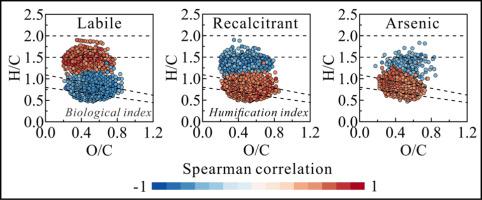Journal of Hazardous Materials ( IF 13.6 ) Pub Date : 2020-11-28 , DOI: 10.1016/j.jhazmat.2020.124702 Wen Qiao , Huaming Guo , Chen He , Quan Shi , Bo Zhao

|
Dissolved organic matter (DOM) is a crucial controlling factor in mobilizing arsenic. However, direct delineations of DOM regarding both optical properties and molecular signatures were rarely conducted in high-arsenic groundwater. Here, both groundwater and surface water were taken from the Hetao Basin, China, to decipher DOM properties with both optical spectrophotometer and Fourier transform ion cyclotron resonance mass spectrometry. The tryptophan-like component (C4) was averagely less than 30% in groundwater DOM, being positively associated with high H/C-ratio molecules (H/C > 1.2) and mainly grouped as highly unsaturated and phenolic compounds and aliphatic compounds. Other three humic-like components (C1, C2, C3) had positive associations with low H/C-ratio molecules (H/C < 1.2), which mainly consisted of highly unsaturated and phenolic compounds, polyphenols, and polycyclic aromatics. Groundwater arsenic concentrations were positively correlated with humic-like, low H/C-ratio, and recalcitrant organic compounds, which may be the consequence of labile organic matter degradation. The degradation caused Fe(III) oxide reduction and mobilized the solid arsenic. In addition, high abundances of these recalcitrant organic compounds in high-arsenic groundwater may contribute to arsenic enrichment via electron shuttling, competition for surface sites, and complexation process. It suggested that groundwater proxies would be either the result or the cause of biogeochemical processes in aquifers.


























 京公网安备 11010802027423号
京公网安备 11010802027423号